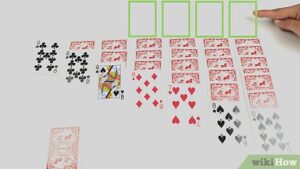Introduction
Solitaire is a classic card game that has captivated players for centuries with its blend of strategy and chance. This article provides a thorough guide on how to play Solitaire, including its rules, strategies, and variations. Whether you’re a beginner or a seasoned player, this guide will help you master the game and enjoy the challenge it offers.
Define the Game
Solitaire is a single-player card game that involves arranging cards in a specific order to achieve a predefined goal, usually by sorting cards into piles. The game is often played with a standard 52-card deck and is known for its varying degrees of difficulty and strategic depth.
Explain Its Relevance and Importance
Solitaire is not just a pastime; it is a game that sharpens cognitive skills such as problem-solving, pattern recognition, and strategic thinking. Its simplicity and accessibility make it a popular choice for relaxation and mental exercise.
Types and Categories of Solitaire
Classic Solitaire (Klondike)
This is the most widely recognized version of Solitaire, often referred to simply as “Solitaire” on computers and mobile devices.

Spider Solitaire
A more complex variation that involves arranging cards in descending order and requires multiple decks.
FreeCell Solitaire
A variant where all cards are dealt face-up and players use free cells as temporary storage to help in organizing the deck.
Pyramid Solitaire
A game where cards are arranged in a pyramid shape and players remove pairs of cards that add up to a specific value.
Golf Solitaire
A solitaire game where the goal is to move cards to a foundation by matching them with a card of the same rank or one rank higher or lower.
Common Solitaire Variations
Single Deck Solitaire
The traditional version using one deck of 52 cards.
Multi-Deck Solitaire
Versions that use two or more decks, such as Spider Solitaire, which uses two decks.
Online Solitaire
Digital versions available on various platforms, often including features like hints, undo options, and customizable rules.
Solitaire Setup and Layout
Deck Preparation
- Shuffle a standard 52-card deck.
- Deal cards according to the variant you’re playing (e.g., Klondike involves dealing seven tableau piles).
Tableau and Foundation Setup
- In Klondike Solitaire, the tableau consists of seven piles with increasing numbers of cards from left to right.
- The foundation piles are where cards are ultimately moved to complete the game.
Stock and Waste Piles
- The stock pile contains remaining cards not initially dealt.
- The waste pile is where cards from the stock pile are placed after being drawn.
Basic Rules of Solitaire
Klondike Rules
- Tableau Arrangement: Cards in the tableau are arranged in descending order and alternating colors.
- Foundation Building: Build foundation piles in ascending order by suit, from Ace to King.
- Card Movement: Move cards between tableau piles, from tableau to foundation, or from stock to tableau.
Spider Solitaire Rules
- Tableau Arrangement: Build tableau piles in descending order by suit.
- Foundation Building: Complete suits from King to Ace to remove them from the tableau.
FreeCell Rules
- Tableau Arrangement: Use free cells as temporary storage to move cards around and build tableau piles in descending order by suit.
- Foundation Building: Build foundation piles in ascending order by suit.
Pyramid Solitaire Rules
- Pyramid Arrangement: Remove pairs of cards that add up to 13 to clear the pyramid.
- Card Movement: Cards can only be removed if they are not blocked by other cards.
Golf Solitaire Rules
- Card Removal: Remove cards by matching them with the card on the top of the foundation pile or one rank higher or lower.
- Game Objective: Clear all cards from the tableau.
Strategies for Winning Solitaire
Klondike Strategies
- Expose Face-Down Cards: Prioritize moves that reveal face-down cards in the tableau.
- Use Empty Columns Wisely: Empty columns are valuable for temporarily moving cards and rearranging the tableau.
Spider Solitaire Strategies
- Build Full Suits: Focus on building complete suits in descending order.
- Manage Empty Columns: Use empty columns to help organize and sort cards more effectively.
FreeCell Strategies
- Plan Moves: Use the free cells strategically and avoid using them too early.
- Build Foundations Early: Start building foundation piles as soon as possible to clear the tableau.
Pyramid Solitaire Strategies
- Remove Pairs Wisely: Prioritize removing cards that block other cards.
- Use Available Cards: Make use of cards that are easily accessible and unblock other cards in the pyramid.
Golf Solitaire Strategies
- Strategic Card Removal: Focus on removing cards that allow access to other cards.
- Card Matching: Pay attention to the card values and plan removals to maximize card access.
Advanced Tips and Techniques
Understanding Probabilities
Learn the probabilities of certain moves to make better decisions, particularly in complex variations like Spider Solitaire.
Practice and Patience
Regular practice improves recognition of patterns and strategies, making advanced gameplay more intuitive.
Use of Software Tools
Utilize computer software or apps that provide hints, undo options, and statistical feedback to enhance your skills.

Solitaire in Popular Culture
History and Evolution
Solitaire has been a staple of card games for centuries, evolving from traditional card tables to digital platforms.
Solitaire in Media
Solitaire has appeared in movies, television shows, and books as a symbol of strategy and solitary reflection.
Resources for Solitaire Enthusiasts
Online Solitaire Platforms
Websites and apps offering a range of Solitaire games and variations.
Books on Card Games
Books that provide strategies, history, and variations of Solitaire and other card games.
Forums and Communities
Online communities where players discuss strategies, share tips, and compete in Solitaire challenges.
Conclusion
Solitaire remains a beloved card game due to its mix of strategy and chance. By understanding the various types of Solitaire, mastering the basic rules, and employing effective strategies, players can enhance their enjoyment and skill in the game. Whether you’re playing Klondike, Spider, or any other variation, these tips and resources will guide you toward becoming a Solitaire expert.





